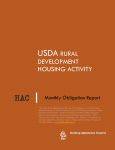HAC News Formats. pdf
July 13, 2016
Vol. 45, No. 13
• FY17 appropriations delayed • Republican officials promise to raise rental housing affordability at party convention • USDA RD launches new online data pages • Report documents severe housing shortfall for extremely low-income renters • Data charts illustrate impact of federal rental assistance • National Housing Trust Fund information posted for states • HUD proposes changes to Housing Choice Voucher administrative fees • Federal agencies define ending chronic homelessness • General section for FY17 HUD NOFAs published
HAC News Formats. pdf
July 13, 2016
Vol. 45, No. 13
FY17 appropriations delayed. The House and Senate have not agreed on any appropriations bills for FY17 and will be out of session from July 18 through Labor Day. During September Congress is expected to pass a continuing resolution or omnibus funding bill to keep the government running after FY16 ends on September 30.
Republican officials promise to raise rental housing affordability at party convention. In an opinion piece for Housing Wire, former Oklahoma governor Frank Keating and former Congressman Rick Lazio point out that rental affordability is a problem in rural places as well as cities. They say “all sensible ideas should be put on the table” and assert that “in Cleveland, we will be doing our best to raise the volume on America’s rental affordability crisis.”
USDA RD launches new online data pages. The Dataset Website offers spreadsheets the public can download and use. Currently available files include multifamily property and management information, entities receiving obligations from rural housing programs during specific months, and tenant characteristics for multifamily properties. Data covering additional months and also single-family housing will be added within the next few weeks.
Report documents severe housing shortfall for extremely low-income renters. The Gap, issued by the National Low Income Housing Coalition, describes a shortage of 7.2 million affordable and available rental units for households with income at or below 30% of their area median. Three-quarters of extremely low-income renters are severely cost-burdened, spending more than half their income on rent and utilities. Data is provided at the national, state, and metropolitan area levels.
Data charts illustrate impact of federal rental assistance. Rental Assistance Reduces Hardship, Promotes Children’s Long-Term Success, a Center on Budget and Policy Priorities chartbook, shows that aid to over 5 million low-income renter households sharply reduces homelessness, housing instability, and overcrowding. It also points out that, due to funding limitations, only one in four eligible households receives federal rental assistance.
National Housing Trust Fund information posted for states. The National Low Income Housing Coalition provides links for each state’s draft allocation plan, notices of public comment periods, submitted comment letters, and state-specific advocacy resources prepared by NLIHC. A calendar lists key dates and upcoming events: public hearings, deadlines for submitting comment periods, and advocacy meetings. Contact outreach@nlihc.org.
HUD proposes changes to Housing Choice Voucher administrative fees. Currently, administrative fees for PHA are based on the number of vouchers under lease and a percentage of the 1993 or 1994 local fair market rent, with an annual inflation adjustment. Based on recommendations of a study that measured actual costs, HUD suggests modifications. Ongoing fees would be based on six variables, and HUD could provide additional fees to address program priorities such as the HUD-Veterans Affairs Supportive Housing program and serving homeless households. Comments are due October 4. Contact Amy Ginger, HUD, 202-402-5152.
Federal agencies define ending chronic homelessness. In June the U.S. Interagency Council on Homelessness and its 19 federal agency members released criteria and a benchmark that describe and quantify ending chronic homelessness in a community. The criteria include effective outreach, access to shelter, a community-wide Housing First approach, and more. To account for those who do not accept repeated offers of assistance and for changes in individual situations, the benchmark acknowledges that a small proportion of a community’s population may continue to experience chronic homelessness.
General section for FY17 HUD NOFAs published. Its provisions will apply to notices of available FY17 funds, which will be issued after September 30, 2016.
Please nominate national or local rural housing leaders for HAC awards! Nominations are due September 30 for the Cochran/Collings Award for national rural housing service and the Skip Jason Community Service Award. The honors will be presented at the National Rural Housing Conference, November 29-December 2. Complete the online nomination form on HAC’s website. Questions? Contact Lilla Sutton, HAC, 202-842-8600.

